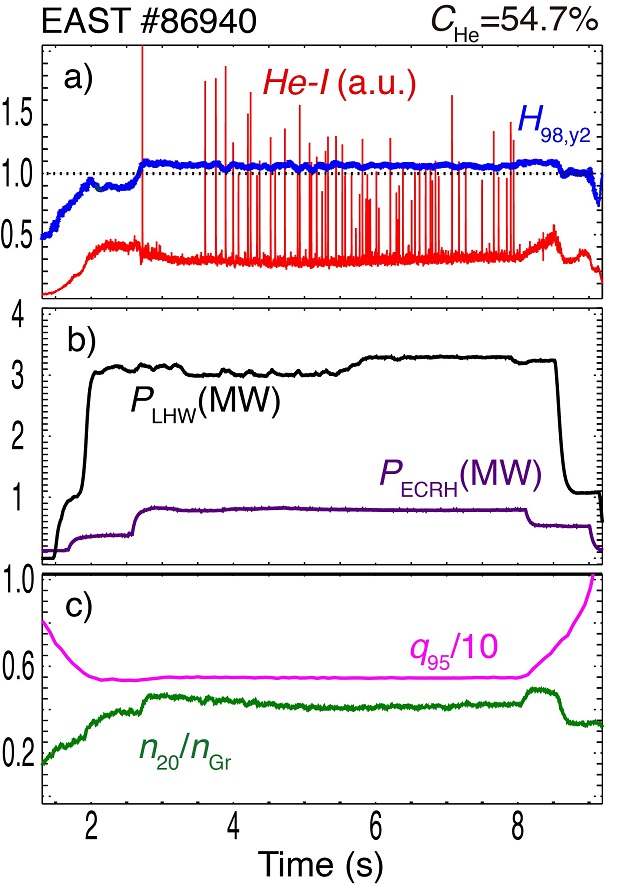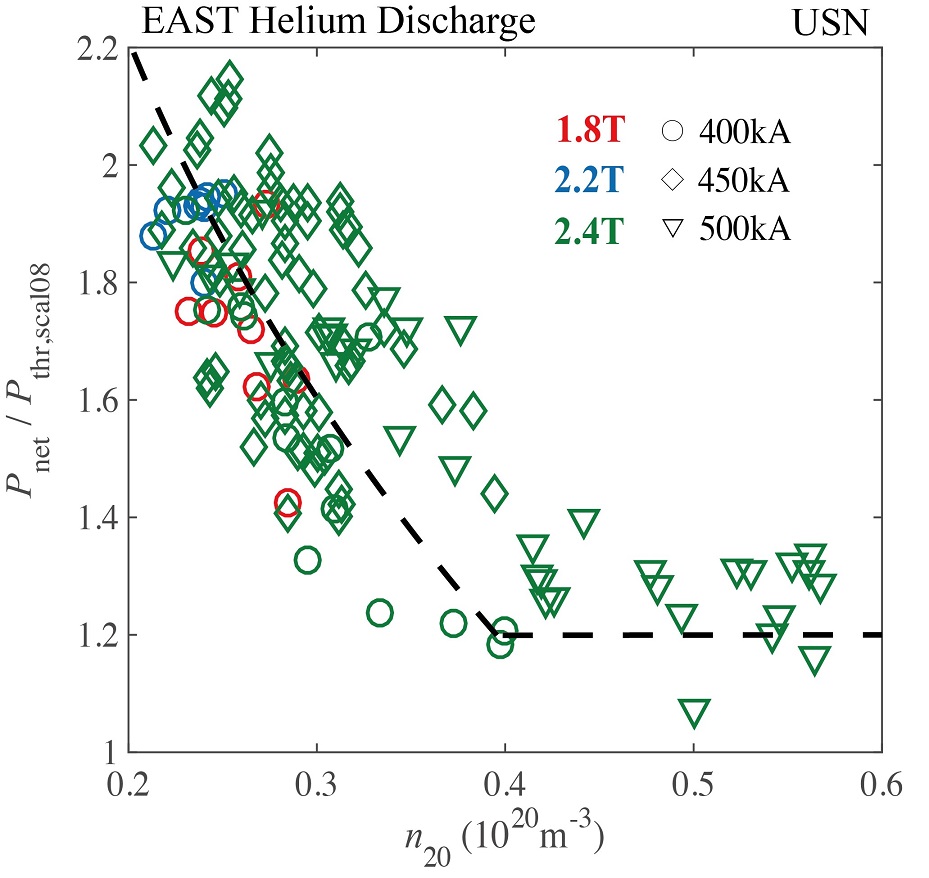Speaker
Description
The helium plasmas have been demonstrated for the first time on EAST under the condition of pure RF-heating and ITER-like tungsten divertor, which advances physical understanding in support of the ITER non-nuclear operational phase $[1]$. Concentration of helium ($C_{He}$) in the plasma is confirmed to play a critical role in H-mode operation, as higher concentration raises the H-mode threshold power and deteriorates the energy confinement in H-mode. At lower $C_{He}$, EAST achieves the stationary Type-I ELMy H-mode over 80 energy confinement time with the energy confinement slightly above $H_{98,y2}$ scaling ($H_{98,y2} \approx 1.1$) by using pure RF power.

EAST first H-mode in helium plasma is achieved by optimizing plasma shape to improve LHW coupling and particle exhaust. Results suggest that a higher possibility of stationary Type-I ELMy H-mode comes with lower $C_{He}$, pedestal electron collisionality and edge safety factor $q_{95}$. Figure 1 shows an example of high performance H-mode discharge ($I_P$ = 0.5MA, $B_T$ = 2.4T, $q_{95}$ = 5.5) with characteristic of Type-I ELMs behavior ($f_{ELM}$ ~ 5-30Hz) from 3.5s to 8.0s. The plasma configuration is an upper single null (USN) with the strike points located on the vertical targets of tungsten divertor. With growing $C_{He}$ under identical experimental conditions, the ELM behavior evolves into higher frequency ~100Hz, or even ELM-absent. ELM mitigation and suppression are demonstrated by n=1 resonant magnetic perturbation (RMP) coils and boron powder injection method, which shows little deleterious effect on core plasma performance for both.
Experiments on the exploration of high energy confinement operation have shown that the global energy confinement time in He is about 30% lower than in D, similar to AUG results $[2]$. For both ion species, the energy confinement time steadily elevate with central line-averaged density over the range of 2-5$\times10^{19}m^{-3}$. In fixed plasma condition ($I_P$ = 0.5MA, $B_T$ = 2.4T, $n_e$ = 4.3$\times10^{19}m^{-3}$, $P_{inj}$ = 4MW), $C_{He}$ lowered by active D gas puffing gradually improves the H-mode performance.

Using the density scan, EAST achieves H-mode over wide density range of 2-6$\times10^{19}m^{-3}$ with the RF heating, where H-mode threshold power ($P_{thr}$) indicates strong dependence on density. Figure 2 presents the statistic result of normalized threshold power (radiated power subtracted), versus density, exhibiting a minimum of $P_{thr}$ at $n_{e,min} \approx 4\times10^{19}m^{-3}$. When plasma densities are below ne,min, the required power to enter H-mode in He is 1.2-2.2 times higher than the ITPA scaling for D $[3]$, otherwise it follows the scaling. The scatter of threshold power at one certain density is attributed to the variation of $C_{He}$. It is not possible to access H-mode at $C_{He}$ > 70% with the available heating power level at the time of experiments.
In summary, recent EAST experiments demonstrates high performance H-mode operation in helium plasma with RF-only heating. More analysis of experimental data from core and edge diagnostics is ongoing, to investigate physical mechanism of $C_{He}$ effect on H-mode operation. With the upgrades $[4]$ in 2020, EAST will be able to further extend high performance helium H-mode towards ITER-relevant by exploiting two extra ECH gyrotrons and the condition of full metal walls.
This work was supported by the Foundation of President of Hefei Institutes of Physical Science CAS under Grant No. YZJJ2018QN8.
$[1]$ ITER Physics Basis Editors 1999 Nucl. Fusion 39 2137
$[2]$ Ryter F. et al 2009 Nucl. Fusion 49 062003
$[3]$ Martin Y.R. et al 2008 Journal of Physics: Conference Series 123 012033
$[4]$ Wan B. et al this conference
| Affiliation | Institute of Plasma Physics, Chinese Academy of Sciences |
|---|---|
| Country or International Organization | China |
